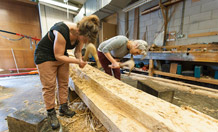
Volunteers working on Bronze Age boat at the National Maritime Museum, Cornwall (copyright of Andrew Stagg)
Bronze Age boat project reaches milestone
The University of Exeter’s ambitious prehistoric boat building project has reached a milestone with the laying of the keel, which forms the backbone of the vessel. Visitors to the National Maritime Museum Cornwall witnessed this significant moment.
The ‘laying down of the keel’ is a momentous event in the construction of any boat and is a significant development in the archaeological experiment to build a full size 16-metre-long replica Bronze Age boat based on the oldest remains ever found in Europe.
Andy Wyke, boat collections manager at National Maritime Museum Cornwall said: “4,000 years ago the keel was part of a jigsaw of very complex technology, today the process looks basic. However, our exhibition and project allows you to go back in time to the Bronze Age, to view the tools that are being used to create the boat and see the methods and skills being adopted. Once you have absorbed the history and heritage of what’s happening before your eyes, you can’t help but admire the innovation and draw breath at the sheer scale of the operation, then and now.”
The collaborative project between the University of Exeter and the National Maritime Museum Cornwall, to build the oldest replica of a Bronze Age sewn-plank boat, is being led by Professor Robert Van de Noort and funded by the Arts and Humanities Research Council (AHRC). One of the world’s leading experts in Bronze Age period boats, University of Exeter archaeologist, Professor Van de Noort is heading up the project and getting hands-on with the boat build.
Professor Van de Noort said: “It’s one thing to know of the processes behind the evolution of these boats but it’s another to actually get to grips with the tools and learn the skills used to create them. Spending time working with the teams on the construction has led to a new level of discovery and we’re all looking forward to exploring the next chapter in this first for investigative archaeology.”
A team of 30 volunteers from around the globe, led by professional boat builder, Brian Cumby, form just some of the team behind this first ever archaeological experiment. Individuals from Norway, Turkey, France and, more locally, Cornwall have poured hours of work into getting the oak to this stage.
Brian Cumby, Project Manager, says: “We’re a third of the way there and I’ve lost pounds in body weight. We’re re-enacting history, achieving something that has never been done before and this live reconstruction allows us to find out more about the processes behind building a sewn-plank boat, to examine the seaworthiness of such vessels and to understand how it was built and sailed.
“Now the process begins of splitting logs, making planks, using fibres from the branches of yew trees and stitching the planks. As we edge closer to the end of the build, we’ll be using moss to stop any leaking before launching the full scale prehistoric replica on Falmouth’s waters at the end of September.”
2012BC Cornwall and the Sea in the Bronze Age exhibition is open until 30 September with the launching of the replica vessel forming the finale of the project. A two-day conference will follow discussing the observations made during the build with a host of experts on the Bronze Age from across Europe.
Date: 3 July 2012
